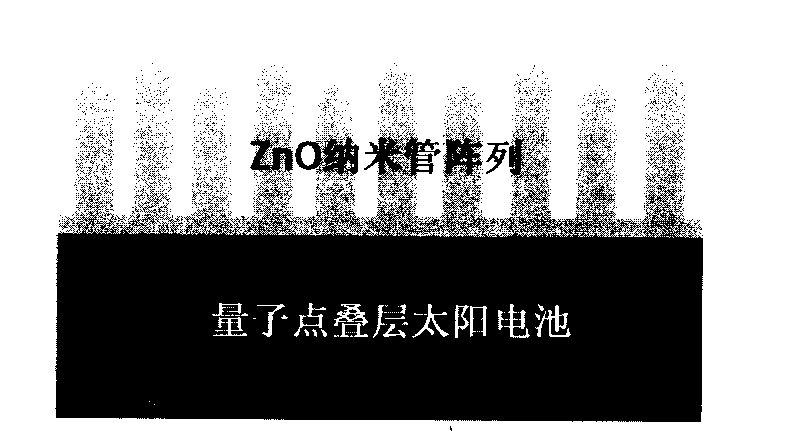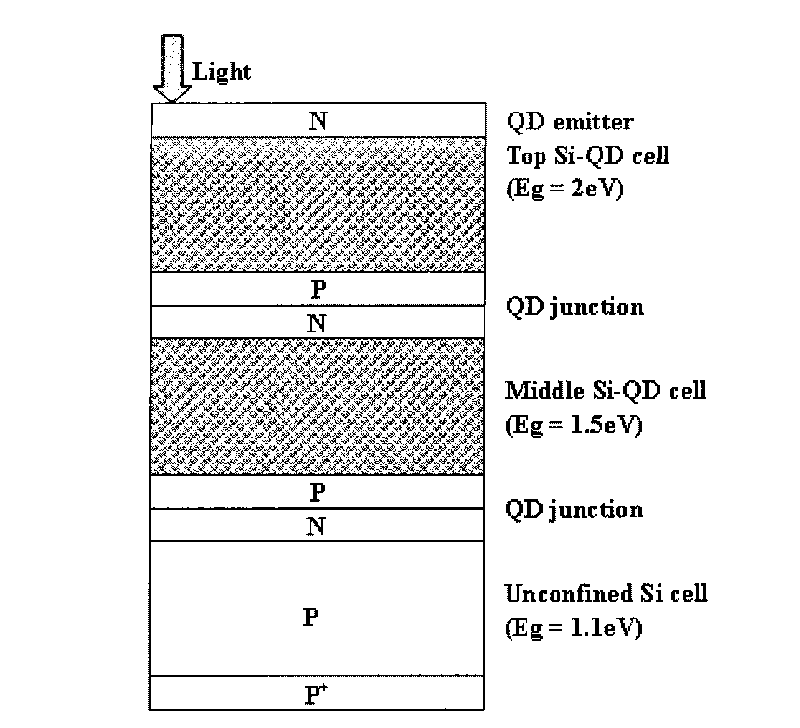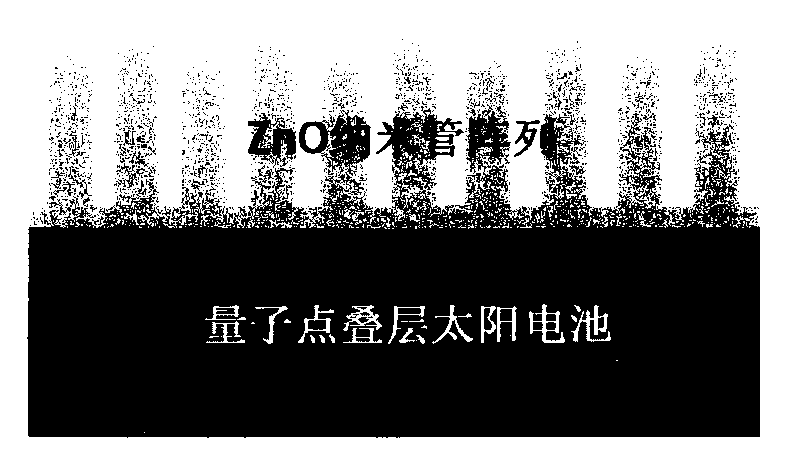Cascade solar cell with nano rod array optical coupling element
A nanorod array, stacked solar technology, applied in the field of solar cells, can solve problems such as limitations, and achieve the effects of improving absorption efficiency, improving flexibility, and reducing manufacturing costs
- Summary
- Abstract
- Description
- Claims
- Application Information
AI Technical Summary
Problems solved by technology
Method used
Image
Examples
Embodiment 1
[0013] Such as figure 1 As shown, the embodiment uses a vertical ZnO nanorod array as the anti-reflection layer. ZnO has a suitable refractive index (n=2) and band gap (~3.3eV), and is used in the anti-reflection layer of solar cells, which has the advantages of high transmission, low broad-spectrum reflection and low absorption. Such as figure 2 As shown, the tandem solar cell uses upper, middle and lower cells, the lower cell uses a conventional Si cell (with a band gap of 1.1eV), and the upper cell and the middle cell use Si quantum dot cells. In order to achieve the absorption of the solar spectrum For matching, the band gaps of the upper and lower Si quantum dot solar cells are respectively 2eV and 1.5eV, and the corresponding Si quantum dot sizes are 20nm and 65nm respectively. Semiconductor quantum dots are made of SiO 2 、Si 3 N 4 and SiC-based Si quantum dots. According to needs, the number of quantum dot laminated sub-batteries is 1, 2, 3, ..., up to n. The ba...
Embodiment 2
[0015] Examples using vertical TiO 2 The nanorod array is an anti-reflection layer. TiO 2 With a suitable refractive index and band gap (~3.2eV), it is used in the anti-reflection layer of solar cells, and has the advantages of high transmission, low broad-spectrum reflection and low absorption. Such as figure 2 As shown, the tandem solar cell uses upper, middle and lower cells, the lower cell uses a conventional Si cell (with a band gap of 1.1eV), and the upper cell and the middle cell use Si quantum dot cells. In order to achieve the absorption of the solar spectrum For matching, the band gaps of the upper and lower Si quantum dot solar cells are respectively 2eV and 1.5eV, and the corresponding Si quantum dot sizes are 20nm and 65nm respectively. Semiconductor quantum dots are made of SiO 2 、Si 3 N 4 and SiC-based Si quantum dots. According to needs, the number of quantum dot laminated sub-batteries is 1, 2, 3, ..., up to n. The battery material adopts Si and TiO ...
Embodiment 3
[0017] Examples using vertical SiO 2 The nanorod array is an anti-reflection layer. SiO 2 With a suitable refractive index (~1.8), it is used in the anti-reflection layer of solar cells, and has the advantages of high transmission and low broad-spectrum reflection. Such as figure 2 As shown, the tandem solar cell uses upper, middle and lower cells, the lower cell uses a conventional Si cell (with a band gap of 1.1eV), and the upper cell and the middle cell use Si quantum dot cells. In order to achieve the absorption of the solar spectrum For matching, the band gaps of the upper and lower Si quantum dot solar cells are respectively 2eV and 1.5eV, and the corresponding Si quantum dot sizes are 20nm and 65nm respectively. Semiconductor quantum dots are made of SiO 2 、Si 3 N 4 and SiC-based Si quantum dots. According to needs, the number of quantum dot laminated sub-batteries is 1, 2, 3, ..., up to n. The battery material adopts Si and SiO 2 , which is rich in resources ...
PUM
 Login to View More
Login to View More Abstract
Description
Claims
Application Information
 Login to View More
Login to View More - R&D
- Intellectual Property
- Life Sciences
- Materials
- Tech Scout
- Unparalleled Data Quality
- Higher Quality Content
- 60% Fewer Hallucinations
Browse by: Latest US Patents, China's latest patents, Technical Efficacy Thesaurus, Application Domain, Technology Topic, Popular Technical Reports.
© 2025 PatSnap. All rights reserved.Legal|Privacy policy|Modern Slavery Act Transparency Statement|Sitemap|About US| Contact US: help@patsnap.com



